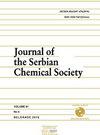Utilization of Jamun seed (Syzyum Cumini) biochar for removal of Fuchsin dye from aqueous solution
IF 0.7
4区 化学
Q4 CHEMISTRY, MULTIDISCIPLINARY
引用次数: 0
Abstract
The textile, leather, paint and other industries discharge lots of dyes in their effluent which can cause major impact to environment and human life. Therefore, it becomes necessary to eliminate the dye from the effluent before its discharge and reuse. Several procedures for the removal and inactivation of dyes have been proposed over past but the adsorption has gained popularity due to its efficiency and operational ease. Use of the biochars as an adsorbent is gaining attention due to their low cost, availability and high adsorption capability. The current study focuses on the removal of Basic Fuchsin (BF) dye through adsorption using Jamun (Syzyum Cumini) seed powder biochar as an adsorbent. The biochar was characterized through various analyses such as: XRD, EDS, FTIR, TGA and SEM. Adsorption was studied by varying the parameters such as pH, contact duration, temperature, adsorbent dose, and temperature. Further, the isotherm, kinetic, and thermodynamic studies were also performed to understand the adsorption mechanism. The maximum adsorption capacity for BF dye was found with Jamun seed biochar produced at 500?C. The study reveals that the biochar manufactured from Jamun seed power has significant potential for elimination of BF dye from wastewater.利用Jamun种子(Syzyum Cumini)生物炭去除水溶液中的品红染料
纺织、皮革、涂料等行业排放大量染料,对环境和人类生活造成严重影响。因此,有必要在废水排放和再利用之前将染料从废水中去除。过去已经提出了几种去除和失活染料的方法,但吸附法因其高效和易于操作而受到欢迎。生物炭作为吸附剂因其成本低、可用性好、吸附能力强等优点而受到广泛关注。本文主要研究了以Jamun (Syzyum Cumini)种子粉生物炭为吸附剂,吸附去除碱性品红(BF)染料。通过XRD、EDS、FTIR、TGA、SEM等多种分析手段对生物炭进行了表征。通过改变pH、接触时间、温度、吸附剂剂量和温度等参数来研究吸附。此外,还进行了等温线、动力学和热力学研究,以了解吸附机理。在500℃条件下生产的Jamun种子生物炭对BF染料的吸附量最大。该研究表明,以蚕豆籽粉为原料制备的生物炭具有显著的去除废水中BF染料的潜力。
本文章由计算机程序翻译,如有差异,请以英文原文为准。
求助全文
约1分钟内获得全文
求助全文
来源期刊
CiteScore
1.80
自引率
0.00%
发文量
76
审稿时长
1 months
期刊介绍:
The Journal of the Serbian Chemical Society -JSCS (formerly Glasnik Hemijskog društva Beograd) publishes articles original papers that have not been published previously, from the fields of fundamental and applied chemistry:
Theoretical Chemistry, Organic Chemistry, Biochemistry and Biotechnology, Food Chemistry, Technology and Engineering, Inorganic Chemistry, Polymers, Analytical Chemistry, Physical Chemistry, Spectroscopy, Electrochemistry, Thermodynamics, Chemical Engineering, Textile Engineering, Materials, Ceramics, Metallurgy, Geochemistry, Environmental Chemistry, History of and Education in Chemistry.

 求助内容:
求助内容: 应助结果提醒方式:
应助结果提醒方式:


